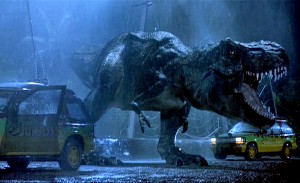 “Get on a web series” is popular advice to up and coming actors these days. And why not? They’re new, hot and popping up everywhere - and who knows, maybe it could lead to stardom. However, this writer’s experience is, most web series suck. Despite often great marketing, content heavy websites and even star power, the majority of web shows suffer from low production value, weak storylines and sub-par or outright amateurish acting. Since low barrier to entry and huge audience potential makes this a powerful medium we need to get to the bottom of the problem.
“Get on a web series” is popular advice to up and coming actors these days. And why not? They’re new, hot and popping up everywhere - and who knows, maybe it could lead to stardom. However, this writer’s experience is, most web series suck. Despite often great marketing, content heavy websites and even star power, the majority of web shows suffer from low production value, weak storylines and sub-par or outright amateurish acting. Since low barrier to entry and huge audience potential makes this a powerful medium we need to get to the bottom of the problem.
With a web series, the same rules apply to making a successful television series, feature film or stage play… you need a good story, perfectly executed. And that, my friends, starts with good, ol’ fashioned writing.
So, can you squeeze a well-developed and compelling storyline into ten minutes (tops) of tight, fun entertainment? Then writing internet programming could be your calling. Doors, a web series from Lloyd Pictures set for a Halloween release, targets the short attention span, yet always content-hungry internet masses.
“A single location with minimal characters allows for tighter shoots and higher production value,” says Raymond Lloyd, writer and director of the series. “But, as with any production, ultimately it’s the story that keeps viewers coming back for more.”
The secret to success then, you ask? Create an intriguing, complex world in a single location with compelling characters. Many writers will confess that it wasn’t until forced into this quandary that they emerged skillful storytellers. Limitations lead to creativity, and after all, that’s what storytelling is all about.
.
Tags: · Doors, how to write a web series, Lloyd Pictures, screenplay, script, web series, writing a web series
December 12th, 2012 · Comments Off on High Concept Screenplay Defined
 By Steve Kaire
By Steve Kaire
High Concept is a term that’s been confused, misunderstood and misused by writers for decades. The common belief is that it’s any movie that can be pitched in one sentence. A man who battles his wife for custody of their children is one sentence, but it’s a million miles from being High Concept.
Others define it by describing it as “one film crossed with another film.” In Robert Altman’s The Player, the writers pitch their project to a producer as Out of Africa meets Pretty Woman. That is not what a High Concept film is. What they used is a framing technique that is given prior to pitching your project to prepare the listener for what’s coming. You cross two well known films that touch upon the material you are about to pitch so the producer has some idea where you’re going with your pitch. That is an example of a common pitching technique and not what defines High Concept.
Story ideas, treatments and screenplays can all have High Concept premises. But only High Concept projects can be sold from a pitch because they are pitch driven. Non-High Concept projects can’t be sold from a pitch because they are execution driven. They have to be read to be appreciated and their appeal isn’t obvious by merely running a logline past someone. This is the reason why films like “Pulp Fiction,” “Star Wars” and “Sideways” could never be sold from a pitch.
In defining High Concept, we talk about the premise of your story, not what happens in Acts 1, 2 and 3. The premise or logline is the core of High Concept. My comprehensive definition of High Concept is comprised of five requirements, each of which is mandatory. The five requirements are in descending order of importance. Therefore, numbers one and two are the most important as well as the most difficult to attain. But meeting only several of the requirements is not enough. All five requirements have to be met for success in achieving the “slam dunk” project everyone is looking for.
Requirement #1:
YOUR PREMISE SHOULD BE ORIGINAL AND UNIQUE
A logline is generally one to five sentences, with the average being three. Therefore, you have to pitch your material in a compressed, economical manner which captures the essence of your story and showcases its originality. Most of my pitches are one or two sentences long. Every writer should practice pitching his or her work by boiling down their story into only one sentence regardless if their story is High Concept or not.
In seeking originality, we are not talking about reinventing the wheel. We can take traditional subject matter that’s been done before and add a hook or twist to it which then qualifies the material as original. Using the kidnapping plot, there have been dozens of films which covered that subject area before. In the film Ransom, Mel Gibson plays a wealthy businessman whose son is kidnapped. That story in itself offers nothing new. The hook of the movie which makes it original is that instead of paying the ransom, Gibson uses the ransom money to pay for a contract hit on the kidnappers. That twist makes the film original and therefore High Concept.
Staying with the same kidnapping genre, the comedy Ruthless People follows the same pattern. Danny Devito plays a wealthy man whose wife, played by Bette Midler, gets kidnapped. Challenging convention, Devito refuses to pay the ransom because he hates his wife and sees this as the opportunity he’s been waiting for to finally get rid of her. Now the bungling kidnappers are stuck with an impossible woman that they have no idea what to do with. Again, it’s that unique hook that makes this a High Concept film.
Requirement #2:
YOUR STORY HAS TO HAVE MASS AUDIENCE APPEAL
That means it’s possible to meet Requirement #1 by creating an original story that’s never been done before. But that story may be so odd or strange that the appeal exists only in the mind of the writer who created it. No one else.
An example would be if a girl woke up one morning, turned into a butterfly, and flew to the land of Shangri-La. That’s never been done before but who cares? Mass appeal means that nine out of ten people who you pitch your story to would say that they’d pay ten dollars to see your movie first run based solely on your pitch. You have to decide either you’re writing for your own enjoyment or you’re writing to sell. If it’s to sell, then you have to take the marketplace into account.
Requirement #3:
YOUR PITCH HAS TO BE STORY SPECIFIC
That means that within your pitch, you have to have specific details which make your story different and adds color and depth. Let’s take the bank robbing plot. If you came up with a story about three people who want to rob a bank by digging a tunnel underneath it, the response would be, “So what?” A twist on that genre is the movie Going In Style. It’s about three senior citizens who attempt to rob a bank. The wheelman has had his license revoked, the lookout is visually impaired, and the brains of the operation is 75-year-old George Burns. Those specific details enhance the story and keep it from being stale and generic.
Requirement #4:
THE POTENTIAL IS OBVIOUS
If you’re pitching a comedy, then the potential for humor should be obvious within your pitch. People should smile or laugh when you tell it. If you’re pitching an action movie, the listener should be able to imagine the action scenes in his head as your pitching. I sold a project to Miramax called My Kind of Town with the Wayans Brothers attached to star. It is about two guys who want to make a new start in life. They pack up their car and take off with no particular destination in mind. Entering City Hall in some tiny Southern town to get a map, the roof collapses on them and they sue. They win the lawsuit but the town can’t afford to pay them so they’re given the town. The potential for humor is obvious when the Wayans Brothers are given a Southern town to do whatever they please with it.
Requirement #5:
YOUR PITCH SHOULD BE ONE TO THREE SENTENCES LONG
Most pitches should be this length although some set-ups may be more, but you shouldn’t go over five to six sentences. You are not telling what happens in Acts 1, 2 and 3 unless you’re asked to do so later. You’re giving the premise of your story. I’ve spent days shaping my loglines to include as much information in as few words as possible.
I’ve had thousands of projects pitched to me in over twenty years and writers mistakenly think that the longer the pitch, the better the story. No one wants to listen to a pitch that’s a half hour long when I could read the script in less time. I tell writers “Pitch me your story in a couple of sentences.” Most cannot because they don’t know what the five requirements are and lack the practice in condensing and fine-tuning their pitches in advance.
When you’re pitching, you are telling what your story is about, not what happens in the story. You don’t want to begin your pitch with, “My story is about a 26-year-old woman named Jill, who lives in Chicago. She’s unhappy with her life. She goes to her office where she confronts her boss. She quits
and goes home where she fights with her boyfriend.” That is not pitching. That is a boring unfolding of the story which you want to avoid at all costs.
The reaction you want to hear when you pitch is “Wow! Why didn’t I think of that?” or “That’s so good why hasn’t somebody made that movie before?” When the faces in the room light up after you deliver your pitch, you know you’ve got them. That’s the sought after “slam dunk.” That’s what High Concept is all about.
Tags: · High Concept Movie Scripts, High Concept Screenplays, High Concept Scripts
December 3rd, 2012 · Comments Off on POV - A Lesson In Perspective
 MY P.O.V. - HEAVEN
MY P.O.V. - HEAVEN
Light permeates my being, leading me upward to bask in its sweet warmth. An intoxicating aroma sweeps over me and I leap with utter abandon to drift into its bosom of splendor, tumbling softly through towering pillars that pilot me gently to a protective haven where I dip into the vastness and sip nectar from the gods. It consumes me, revitalizes me, and completes me.
A TICK’S P.O.V. - LIFE
…this eyeless animal finds the way to her watchpoint [at the top of a tall blade of grass] with the help of only its skin’s general sensitivity to light. The approach of her prey becomes apparent to this blind and deaf bandit only through her sense of smell. The odor of butyric acid, which emanates from the sebaceous follicles of all mammals, works on the tick as a signal that causes her to abandon her post (on top of the blade of grass/bush) and fall blindly downward toward her prey. If she is fortunate enough to fall on something warm (which she perceives by means of an organ sensible to a precise temperature) then she has attained her prey, the warm-blooded animal, and thereafter needs only the help of her sense of touch to find the least hairy spot possible and embed herself up to her head in the cutaneous tissue of her prey. She can now slowly suck up a stream of warm blood.
I wanna be a tick.
Tags: · movie script POV, screenplay POV, script POV
 “Get on a web series” is popular advice to up and coming actors these days. And why not? They’re new, hot and popping up everywhere - and who knows, maybe it could lead to stardom. However, this writer’s experience is, most web series suck. Despite often great marketing, content heavy websites and even star power, the majority of web shows suffer from low production value, weak storylines and sub-par or outright amateurish acting. Since low barrier to entry and huge audience potential makes this a powerful medium we need to get to the bottom of the problem.
“Get on a web series” is popular advice to up and coming actors these days. And why not? They’re new, hot and popping up everywhere - and who knows, maybe it could lead to stardom. However, this writer’s experience is, most web series suck. Despite often great marketing, content heavy websites and even star power, the majority of web shows suffer from low production value, weak storylines and sub-par or outright amateurish acting. Since low barrier to entry and huge audience potential makes this a powerful medium we need to get to the bottom of the problem.



